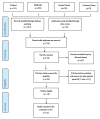Regulatory T Cells in Multiple Sclerosis Diagnostics-What Do We Know So Far?
- PMID: 38248730
- PMCID: PMC10821144
- DOI: 10.3390/jpm14010029
Regulatory T Cells in Multiple Sclerosis Diagnostics-What Do We Know So Far?
Abstract
Background: Multiple sclerosis (MS) is an autoimmune disorder that affects the central nervous system (CNS) through inflammation. MS symptoms become acute if the disease progresses to the relapsing phase.
Aim: This review aimed to evaluate the role played by regulatory T cells (Tregs) in the pathogenesis of MS.
Methods: This review used scholarly journal articles obtained from PubMed, PsycINFO, and CINAHL with different search parameters such as 'regulatory T cells', 'multiple sclerosis', and 'current knowledge'. The process of searching for articles was limited to those that had publication dates falling between 2010 and 2020.
Results: Tregs play a role in the pathogenesis of MS. This conclusion is supported by animal disease models and environmental factors that can underlie Treg alterations in MS. Despite the knowledge of the role played by Tregs in MS pathogenesis, the specific subsets of Tregs involved in MS development remain incompletely understood.
Discussion: This review provides an essential link between Tregs and MS activity. Targeting Tregs could be an efficient way to establish new treatment methods for MS management.
Conclusion: MS is a complex condition affecting many people worldwide. Research has shown that Tregs can influence MS development and progression. More investigations are needed to understand how Tregs affect the pathogenesis of MS.
Keywords: endocrine system; endocrinology; infections.
Conflict of interest statement
The author declares no conflict of interest.
Similar articles
-
Contributions of T cells in multiple sclerosis: what do we currently know?J Neurol. 2021 Dec;268(12):4587-4593. doi: 10.1007/s00415-020-10275-x. Epub 2020 Oct 20. J Neurol. 2021. PMID: 33083867 Review.
-
Dysfunction of IL-10-producing type 1 regulatory T cells and CD4(+)CD25(+) regulatory T cells in a mimic model of human multiple sclerosis in Cynomolgus monkeys.Int Immunopharmacol. 2009 May;9(5):599-608. doi: 10.1016/j.intimp.2009.01.034. Epub 2009 Feb 10. Int Immunopharmacol. 2009. PMID: 19539557
-
Role of Th17 cells in the pathogenesis of CNS inflammatory demyelination.J Neurol Sci. 2013 Oct 15;333(1-2):76-87. doi: 10.1016/j.jns.2013.03.002. Epub 2013 Apr 8. J Neurol Sci. 2013. PMID: 23578791 Free PMC article. Review.
-
Small GTPase RAS in multiple sclerosis - exploring the role of RAS GTPase in the etiology of multiple sclerosis.Small GTPases. 2020 Sep;11(5):312-319. doi: 10.1080/21541248.2018.1502591. Epub 2018 Sep 18. Small GTPases. 2020. PMID: 30043672 Free PMC article. Review.
-
Patients With Severe Multiple Sclerosis Exhibit Functionally Altered CD8+ Regulatory T Cells.Neurol Neuroimmunol Neuroinflamm. 2022 Oct 20;9(6):e200016. doi: 10.1212/NXI.0000000000200016. Print 2022 Nov. Neurol Neuroimmunol Neuroinflamm. 2022. PMID: 36266052 Free PMC article.
Cited by
-
Multiple Sclerosis Research Evolves: A Closer Look at Deep Gray Matter, Sexual Function Rehabilitation, and T Regulatory Cells.J Pers Med. 2024 Feb 12;14(2):202. doi: 10.3390/jpm14020202. J Pers Med. 2024. PMID: 38392635 Free PMC article.
References
-
- Sürücü L., Maslakci A. Validity and reliability in quantitative research. Bus. Manag. Stud. Int. J. 2020;8:2694–2726. doi: 10.15295/bmij.v8i3.1540. - DOI
-
- The George Washington University . Finding Resources: Using Journals for Your Research. The George Washington University; Washington, DC, USA: 2021.
Publication types
LinkOut - more resources
Full Text Sources


